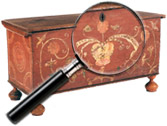|
|
The Winchester Model 1876
The 1876 repeating rifle, often called the “Centennial” rifle because of its date of introduction, was manufactured from 1876 to 1897 during which nearly 64,000 were produced. It was designed primarily for big game hunting and was used by Theodore Roosevelt, among others. It was produced in a variety of caliber, including 40-60, 45-60, 45-75 and 50-95 caliber. The rifle’s serial number is stamped on its lower tang with “Model [...] Click here to continue reading.
The Winchester Model 1866
Winchester produced about 170,000 model 1866′s from 1866 to 1898. The ’66 is often called “the gun that won the west” where the Indians called it “many shots” and “heap firing” guns. It was also known on the frontier as “yellow boy” because of its brass frames. Serial numbers for the ’66 begin at 12,476 and were at first placed beneath the buttstock on the left side of the upper [...] Click here to continue reading.
Celtic Harvest
The Celtic Harvest line of wares was produced from 1937 to 1941 with additional production after WWII until 1964.
Many forms of the pattern included a plated metal part (usually chrome), made by the Celtic Company(pronounced Keltic), hence the Celtic portion of the pattern’s name. Harvest refers to the pattern when there is no plated additions.
Celtic Harvest wares have relief decoration relief molded into the body of the pottery. These [...] Click here to continue reading.
The Packet was published by John Dunlap.
The rolling block action is generally recognized as one of the strongest ever made. The pivoting action of its breachblock and hammer act together to form and exceptionally strong closure with the barrel on firing. It is a single shot pistol with an eight inch round barrel. About 6,000 of these pistols were manufactured by Remington in Ilion, New York between 1872 and 1888. About 5,100 of these went to the U.S. Army and [...] Click here to continue reading.
Wheatley Pottery
Wheatley Art Pottery was the product of Cincinnati potter Thomas Jerome Wheatley, who began potting in the 1880′s. His first product was Cincinnati Limoges-style pottery, made in competition with Maria Longworth Nichols of the Rookwood Pottery and Mary Louise McLaughlin. It seems that all three claimed to invented the Cincinnati Limoges technique and lawsuits followed. This period of Wheatley’s work is of historical interest, but fails to distinguish itself from the competition. [...] Click here to continue reading.
Gaudy Dutch Earthenware
Gaudy Dutch is a soft-paste earthenware, or pearlware, made by British potteries for the American export market, especially the color loving “Pennsylvania Dutch”, from approximately 1800 to 1840.
The ware was polychrome decorated in imitation of the Japanese Imari porcelains in shades of red, black, blue, green and yellow. A variety of forms, including plates, cup-plates, coffee and teapots, sugar bowls and cream pitchers were made in sixteen patterns: Butterfly, Carnation, [...] Click here to continue reading.
Netsuke
Overview
Having no pockets in their traditional kimono dress, the Japanese, beginning in the 17th century, developed a miniature sculptural form called a netsuke (pronouced net-ski in the west, but closer to netskeh in Japanese) to function as a toggle securing personal items to their robe’s sash (called an obi).
Netsuke are mostly a feature of Japanese male culture. Women would tuck small personal items into their sleeves, but men suspended their accesories [...] Click here to continue reading.
Associated American Artists
In 1934, Reeves Lewenthal founded Associated American Artists. Lewenthal contacted many prominent American artists with the notion of publishing their prints in editions of 250 impressions to be offered to the public. Thomas Hart Benton, Will Barnet, Rockwell kent and Grant Wood are only a few of the important artists who accepted this offer. The first gallery was located at 420 Madison Avenue in New York.
Among the initial group of [...] Click here to continue reading.
Gunderson Glass Works
Gunderson Glass Works was established in 1939 when Robert Gunderson and two partners purchased the silverware and glass business of the Pairpoint Glass Co. The works continued to produce glass until Gunderson’s death in 1952. Among the satin glass produced by the works was the Burmese pattern originated and patented by the Mt. Washington Glass Co. in 1885 with production continuing by Pairpoint after its purchase of Mt. Washington, and then [...] Click here to continue reading.
|
Recent Articles
- Charles Alfred Meurer – American Artist & Tromp L’Oeil Artist
- Sendak, Maurice – American Artist & Writer
- Godie, Lee – American Artist
- Davis, Vestie – American Artist
- Bartlett, Morton – American Artist
- Mackintosh, Dwight – American Artist
- Evans, Minnie Jones – African-American Artist
- Mumma, Ed (Mr. Eddy) – American Artist
- Nice, Don – American Artist
- Savitsky, John (Jack) – American Artist
- Gordon, Harold Theodore (Ted) – American Artist
- Dial, Thornton – African-American Artist
- Doyle Sam – American Artist
- Johnson, Lester Frederick – American Artist
- Finster, Howard – American Artist
|
|
